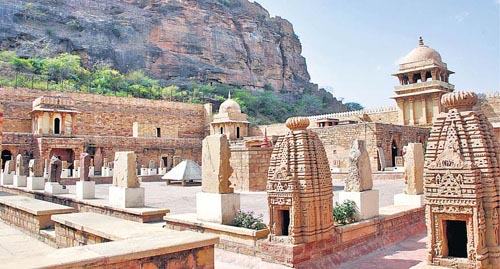Gujari Mahal

Information on Gujari Mahal (Gwalior, Madhya Pradesh) - History & Architecture
Gujari Mahal is located in Gwalior Fort, in the district of Gwalior, in the state of Madhya Pradesh in Central India. The fort was built in the 8th century and the palace was established in 14th century. It was built by the Hindu Kings of India with materials such as sandstones and lime mortar. It is a hill fort with a defensive structure plus two main palaces named as Man Mandir and Gurjari Mahal built by Man Singh Tomar. Over a long period of time, the fort and its palace has been directly and indirectly controlled by a good number of different rulers. This palace was grandly built for Queen Mrignayani. At present, it is an archaeological museum.
Gujari Mahal Architecture
On an outcrop of Vindhyan sandstone on a steep, rocky, solitary, thin and long hill known as Gopachal, Gwalior Fort was built in a successful manner. A small river named Swarnrekha gently flows near the fort and its palace. The fort and its complex are perfectly maintained plus house several historic monuments such as palaces, Hindu temples and large water tanks. The grand palace in the fort premises are the Shah Jahan palace, the Karan palace, the Jahangir palace, the Gujari palace and Man mandir palace. There are also eleven temples dedicated to the tirthankaras of Jainism and Gautama Buddha. The fort rises 35 feet (11 m) in height and covers an area of 3 square kilometres (1.2 sq mi). It has six bastions or towers. Largely due to the undulating ground beneath, the actual profile of the fort and other structure has an irregular appearance. There are two gates for the fort at the southwest known as Elephant gate (Hathi Pul) and northeast known as Badalgarh gate.
Gujari Mahal was grandly built by Raja Man Singh for his beloved wife named Mrignayani who was a Gujar princess. The queen demanded a special and separate beautiful palace for herself. She also wished to have regular water supply directly through an aqueduct from the nearby river named Rai. At present, this palace has been largely converted into an archaeological museum with a good collection of antiques and weapons belonging to the periods.
Gujari Mahal History
According to the local legends, Suraj Sen Kachwaha who was the chieftain of the nearby Silhonia village, received holy water from a saint named Gwalipa (Galava) for the healing of leprosy. Later, the chieftain established Gwalior, naming it after the saint. Historians also indicate a hill fort in this region belonging to the Hun emperor named Mihirakula belonging to the 510 AD. Later, the pal dynasty with 86 kings ruled for nearly 989 years. Then this region was ruled by the Pratihara Dynasty, Suri dynasty, Mughal dynasty, Rana Jat dynasty and Maratha rulers. The Maratha rulers waged many wars with the British force. During those days, the region faced many hardships in all aspects. On 1 June 1858, Jhansi Rani Lakshmi Bai led a rebellion from this fort.
Gujari Mahal Tourism Importance
Gujar Mahal largely attracts domestic and foreign tourists. There are many historical and religious important structures in the fort premises such as Teli ka mandir, Garuda monument, Saas-bahu temple, Karn mahal, Vikram mahal, Chhatri of Bhim Singh Rana, etc that can be visited. It nearly takes a day time to go around the fort complex and enjoy the beauty and architectural skills of the grand structures. The visitors can experience the medieval period touch in the modern city of Gwalior.
- Andaman Nicobar Monuments
- Andhra Pradesh Monuments
- Assam Monuments
- Bihar Monuments
- Chhattisgarh Monuments
- New Delhi Monuments
- Goa Monuments
- Gujarat Monuments
- Haryana Monuments
- Himachal Pradesh Monuments
- Jammu and Kashmir Monuments
- Karnataka Monuments
- Kerala Monuments
- Madhya Pradesh Monuments
- Maharashtra Monuments
- Odisha Monuments
- Punjab Monuments
- Rajasthan Monuments
- Tamil Nadu Monuments
- Telangana Monuments
- Uttar Pradesh Monuments
- West Bengal Monuments